 Search by Keyword
|
“LET IT BE”
(Apple AR-34001)
Released May 18th, 1970
After The Beatles completed the recording of their famous self-titled double album affectionately known as the “White Album,” a two-and-a-half-month rest period ensued that allowed them to recuperate from the tedious five months they spent in the recording studio. As 1969 began, the group broke ground on yet another project that, as fate would have it, mostly sat in limbo for roughly fifteen months before it would see the light of day.
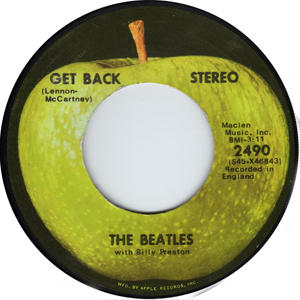 The intention was, of course, for it to be released to the world shortly after it was recorded. In fact, the first evidence of this project came out as the follow-up single to “Hey Jude,” namely, the highly sucessful “Get Back / Don't Let Me Down” release, the a-side spending five weeks in the #1 position on the US Billboard Hot 100 in May and June of 1969. The intention was, of course, for it to be released to the world shortly after it was recorded. In fact, the first evidence of this project came out as the follow-up single to “Hey Jude,” namely, the highly sucessful “Get Back / Don't Let Me Down” release, the a-side spending five weeks in the #1 position on the US Billboard Hot 100 in May and June of 1969.
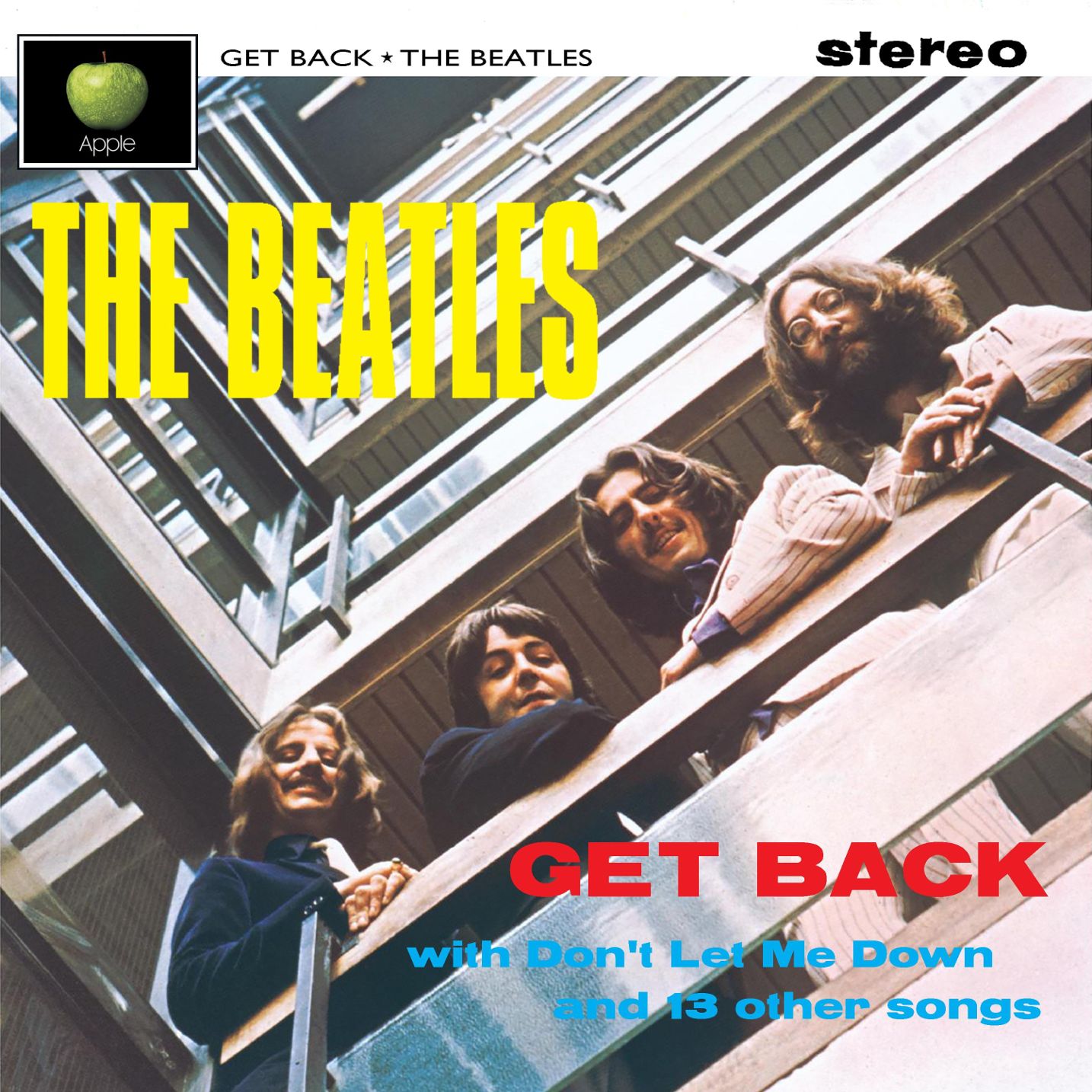 As expected, an album was prepared and readied for release on May 28th, 1969 that included this current single as well as the rest of the material they had recorded for this project. It was expected that this album, entitled “Get Back,” would be in the record stores by summer while the single was still on the charts. However, because the quality of the album, as assembled by producer Glyn Johns, was viewed by The Beatles as substandard, it was not released in that form. Instead, a newly recorded Beatles single, “The Ballad Of John And Yoko / Old Brown Shoe,” was released that summer. As expected, an album was prepared and readied for release on May 28th, 1969 that included this current single as well as the rest of the material they had recorded for this project. It was expected that this album, entitled “Get Back,” would be in the record stores by summer while the single was still on the charts. However, because the quality of the album, as assembled by producer Glyn Johns, was viewed by The Beatles as substandard, it was not released in that form. Instead, a newly recorded Beatles single, “The Ballad Of John And Yoko / Old Brown Shoe,” was released that summer.
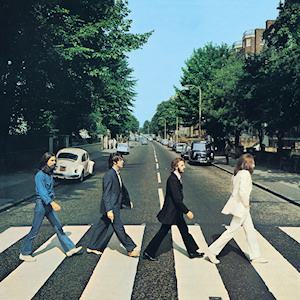 Putting the “Get Back” sessions behind them for the time being, The Beatles continued recording sessions to create a new polished album with producer George Martin, this becoming the painstakingly recorded “Abbey Road” album, which was released in America in the fall of 1969. Putting the “Get Back” sessions behind them for the time being, The Beatles continued recording sessions to create a new polished album with producer George Martin, this becoming the painstakingly recorded “Abbey Road” album, which was released in America in the fall of 1969.
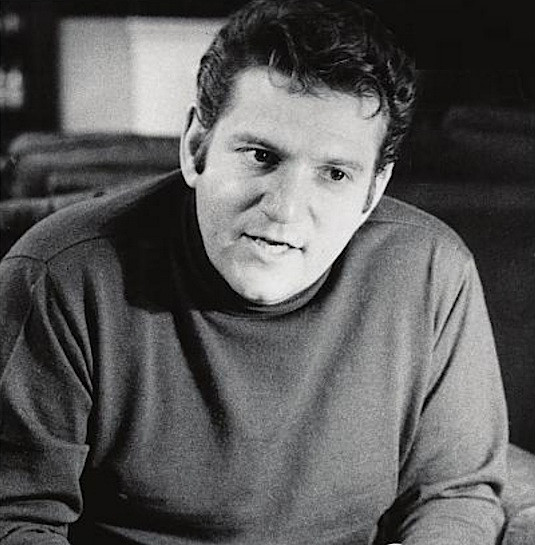 While the future of the group was uncertain, John declaring he wanted “a divorce” from The Beatles in September of 1969, the “Get Back” sessions were still not forgotten. In fact, since the group's rehearsals and recording sessions for this project were filmed, a decision was made by their new manager, Allen Klein, that the footage would be released as a movie in order to fulfill their United Artists contract for three feature films. This being the case, a soundtrack album would be needed. After some additional Beatles recording sessions in early January of 1970, Glyn Johns went to putting together yet another “Get Back” album to be released in conjunction with the released movie. This version of the “Get Back” album was also rejected by The Beatles as substandard. While the future of the group was uncertain, John declaring he wanted “a divorce” from The Beatles in September of 1969, the “Get Back” sessions were still not forgotten. In fact, since the group's rehearsals and recording sessions for this project were filmed, a decision was made by their new manager, Allen Klein, that the footage would be released as a movie in order to fulfill their United Artists contract for three feature films. This being the case, a soundtrack album would be needed. After some additional Beatles recording sessions in early January of 1970, Glyn Johns went to putting together yet another “Get Back” album to be released in conjunction with the released movie. This version of the “Get Back” album was also rejected by The Beatles as substandard.
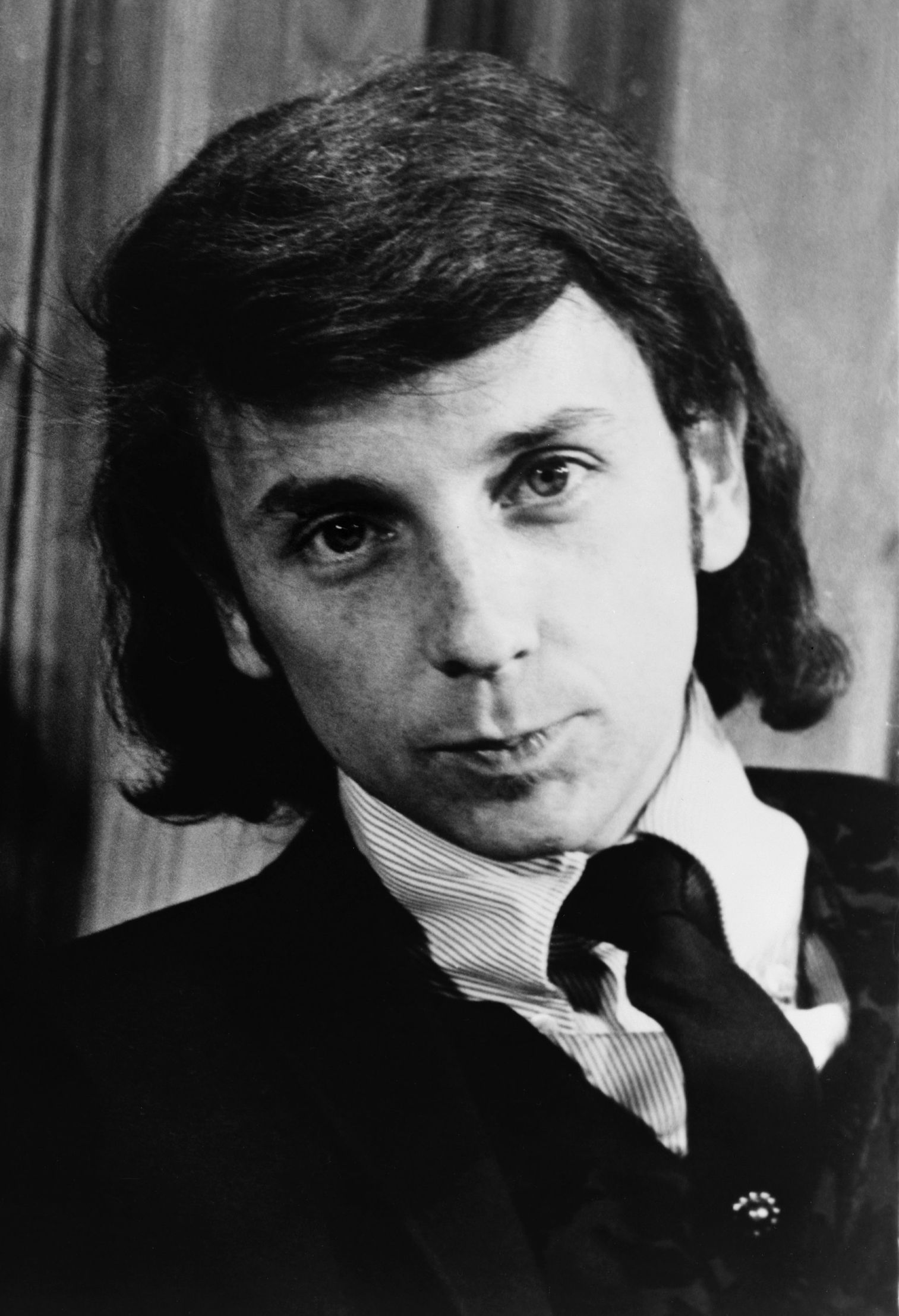 Shortly thereafter, legendary producer Phil Spector was recruited to prepare the soundtrack album for the soon-to-be-released film. The album and movie were now to be entitled “Let It Be” to coincide with what would be their next single, “Get Back” by now being known to the public as a hit Beatles song that would be a year old by the time the album and movie were released in May of 1970. Shortly thereafter, legendary producer Phil Spector was recruited to prepare the soundtrack album for the soon-to-be-released film. The album and movie were now to be entitled “Let It Be” to coincide with what would be their next single, “Get Back” by now being known to the public as a hit Beatles song that would be a year old by the time the album and movie were released in May of 1970.
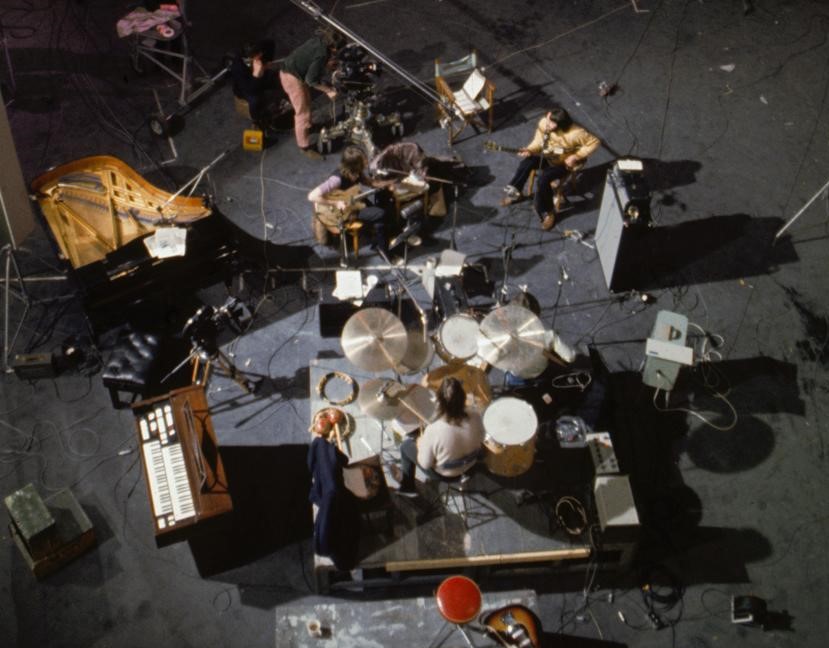
The Beatles at Twickenham Film Studios, January 1969.
Origin Of The Album
Sometime in August of 1968, during the later stages of recording the “White Album,” Paul came up with an idea. In order to promote the new album, and to initiate the return of The Beatles to live performances, he conceived of a plan for a concert at a small local venue, the Roundhouse in London, which would be filmed for a television special. The concert would focus primarily on songs from the “White Album” along with a few earlier Beatles selections.
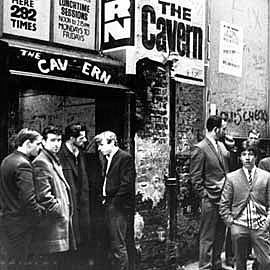 By November of that year it was decided that the Roundhouse would not be a suitable venue for their return to concert performances, while an appeal was made to their fans by Derek Taylor in December for suggestions of where the show could take place. “We could take Chelsea Town Hall, Wembley Stadium or hire a village hall somewhere,” Derek wrote, also inferring that a “return to their Liverpool Cavern Club birthplace” might even be considered. By November of that year it was decided that the Roundhouse would not be a suitable venue for their return to concert performances, while an appeal was made to their fans by Derek Taylor in December for suggestions of where the show could take place. “We could take Chelsea Town Hall, Wembley Stadium or hire a village hall somewhere,” Derek wrote, also inferring that a “return to their Liverpool Cavern Club birthplace” might even be considered.
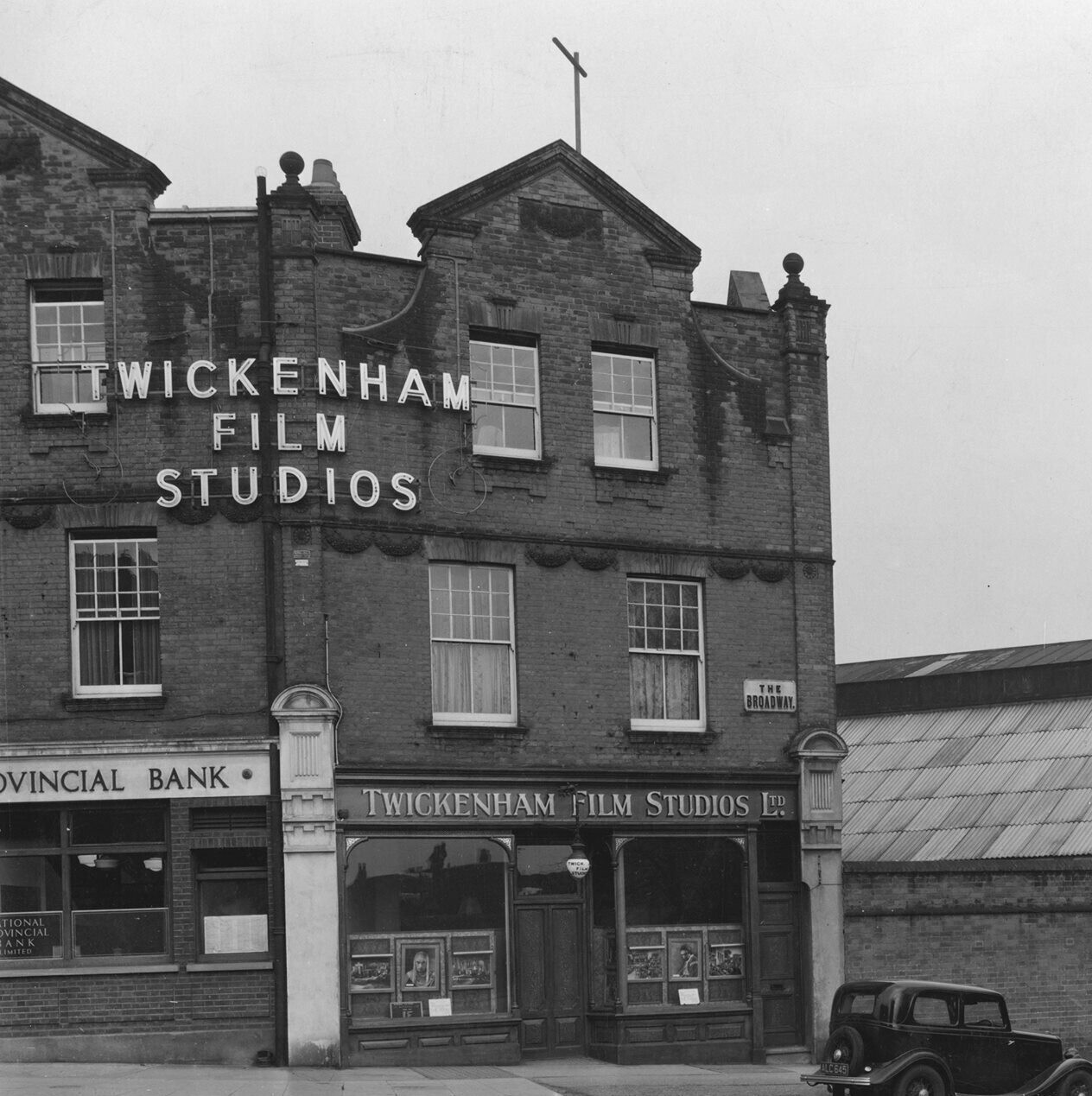 Meanwhile, Paul was so impressed by the promo films the group made at Twickenham Studios in September for their songs “Hey Jude” and “Revolution” that he reenlisted their director Michael Lindsay-Hogg to direct a suitable “Beatles At Work” documentary at these studios to capture the band in rehearsals for this upcoming concert. With availability at Twickenham pushing back this project until January of 1969, well over a month after the release of the “White Album,” it was decided that brand new songs would be required for the project, their November-released double-album being several months old by the time this new venture could see a world-wide premier. Meanwhile, Paul was so impressed by the promo films the group made at Twickenham Studios in September for their songs “Hey Jude” and “Revolution” that he reenlisted their director Michael Lindsay-Hogg to direct a suitable “Beatles At Work” documentary at these studios to capture the band in rehearsals for this upcoming concert. With availability at Twickenham pushing back this project until January of 1969, well over a month after the release of the “White Album,” it was decided that brand new songs would be required for the project, their November-released double-album being several months old by the time this new venture could see a world-wide premier.
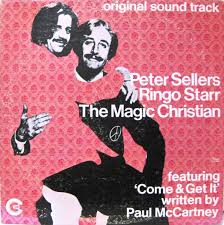 Twickenham Film Studios were available until February of 1969 when filming for the movie “The Magic Christian” (starring Peter Sellers and Ringo Starr) was to begin. Therefore, The Beatles were given the month of January to meet in these cold studios to write, introduce and learn new compositions in preparation for a concert, wherever that would be, when they would premier this new material to the public. Since the purpose of the project was to perform these new songs live, the group adopted a “no overdubs” policy throughout these proceedings, returning to their early days when they didn't depend on studio manipulations of any kind. As Beatles' associate Mal Evans wrote in his diary, "Having gone through the whole phase of recording with 40-piece orchestras and added session musicians, the feeling in the air was that it would be nice to make a group album again." Twickenham Film Studios were available until February of 1969 when filming for the movie “The Magic Christian” (starring Peter Sellers and Ringo Starr) was to begin. Therefore, The Beatles were given the month of January to meet in these cold studios to write, introduce and learn new compositions in preparation for a concert, wherever that would be, when they would premier this new material to the public. Since the purpose of the project was to perform these new songs live, the group adopted a “no overdubs” policy throughout these proceedings, returning to their early days when they didn't depend on studio manipulations of any kind. As Beatles' associate Mal Evans wrote in his diary, "Having gone through the whole phase of recording with 40-piece orchestras and added session musicians, the feeling in the air was that it would be nice to make a group album again."
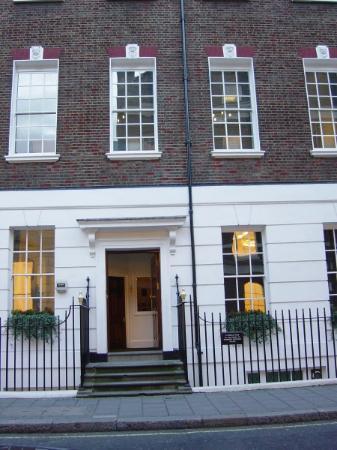 On January 21st, an agreement was made, at the insistence of George Harrison, that they would relocate their rehearsals from the cold Twickenham Studios to their newly renovated recording studio in the basement of their Apple headquarters on Savile Row in London. The remainder of the rehearsals occurred there, George also insisting that his keyboardist friend Billy Preston join the project, as well as the idea of a live concert being dropped. In the end, a compromise was reached in which they premiered many of their new songs in an unannounced performance on the roof of the Apple building on January 30th, 1969. On January 21st, an agreement was made, at the insistence of George Harrison, that they would relocate their rehearsals from the cold Twickenham Studios to their newly renovated recording studio in the basement of their Apple headquarters on Savile Row in London. The remainder of the rehearsals occurred there, George also insisting that his keyboardist friend Billy Preston join the project, as well as the idea of a live concert being dropped. In the end, a compromise was reached in which they premiered many of their new songs in an unannounced performance on the roof of the Apple building on January 30th, 1969.
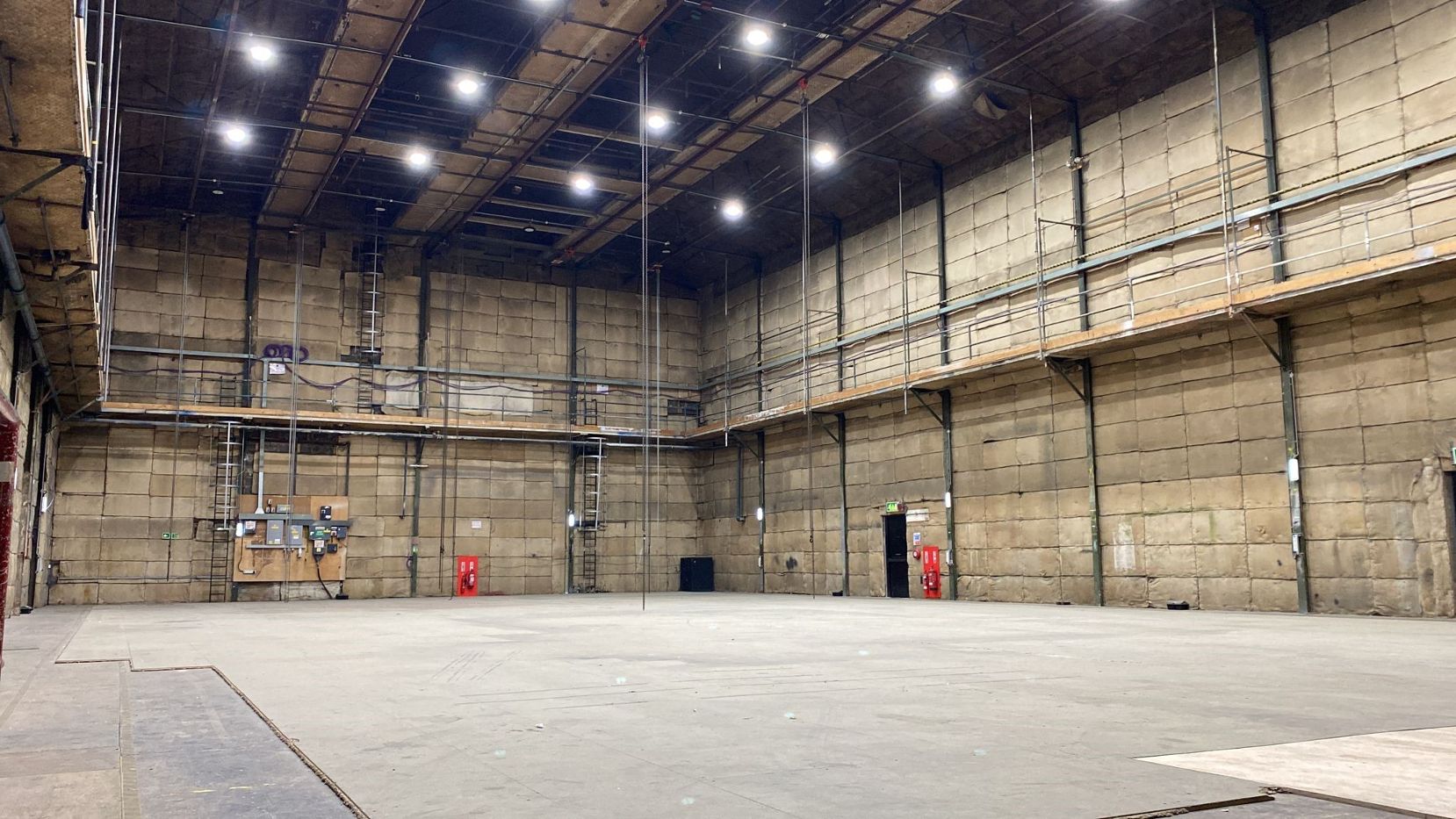 Most recollections of these January sessions were negative. “It was just weird vibes,” George recalled, adding, “It was just too difficult. There were just too many limitations based upon our being together for so long...it was frustrating.” John related: “We couldn't get into it. It was just a dreadful, dreadful feeling at Twickenham Studio. You couldn't make music at eight in the morning, in a strange place with people filming you, and colored lights.” Ringo adds: “The days were long, and it could be boring, and Twickenham just wasn't really conducive to any great atmosphere. It was just a big barn.” Even after moving to their own Apple basement studio, the atmosphere was not the best. “By the time it had been made into a studio, it was covered all over, and made into a crappy place with polystyrene ceilings.” Most recollections of these January sessions were negative. “It was just weird vibes,” George recalled, adding, “It was just too difficult. There were just too many limitations based upon our being together for so long...it was frustrating.” John related: “We couldn't get into it. It was just a dreadful, dreadful feeling at Twickenham Studio. You couldn't make music at eight in the morning, in a strange place with people filming you, and colored lights.” Ringo adds: “The days were long, and it could be boring, and Twickenham just wasn't really conducive to any great atmosphere. It was just a big barn.” Even after moving to their own Apple basement studio, the atmosphere was not the best. “By the time it had been made into a studio, it was covered all over, and made into a crappy place with polystyrene ceilings.”
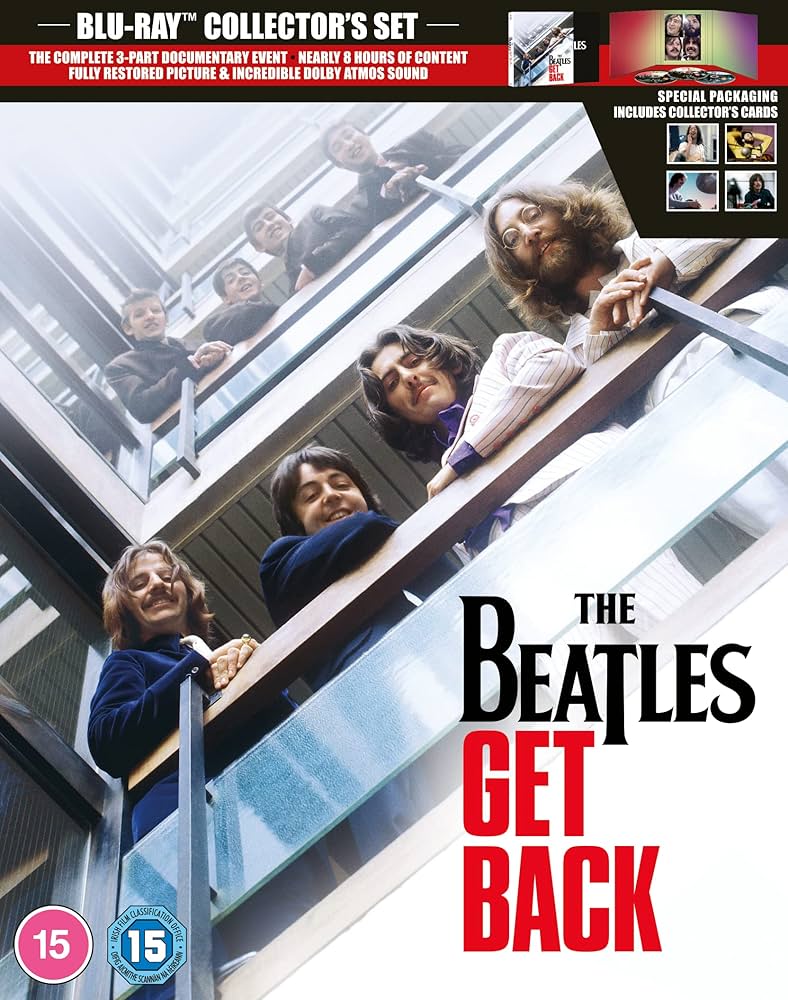 While legend has it that this was the most miserable experience in Beatles' history, an approximate 475 rolls of film that were shot during this month prove otherwise, at lease at times. As seen in the 2021 "Get Back" documentary series, much of the footage reveals the four Beatles having a good degree of fun rehashing old material, humorously batting around new arrangement ideas, and generally clowning around. Many tense segments were purposely included in the resulting “Let It Be” movie to add a bit of shock value. After all was said and done, however, good and bad times included, the result was a set of songs that have stood the test of time, including three US #1 hits. While legend has it that this was the most miserable experience in Beatles' history, an approximate 475 rolls of film that were shot during this month prove otherwise, at lease at times. As seen in the 2021 "Get Back" documentary series, much of the footage reveals the four Beatles having a good degree of fun rehashing old material, humorously batting around new arrangement ideas, and generally clowning around. Many tense segments were purposely included in the resulting “Let It Be” movie to add a bit of shock value. After all was said and done, however, good and bad times included, the result was a set of songs that have stood the test of time, including three US #1 hits.
Recording The Album
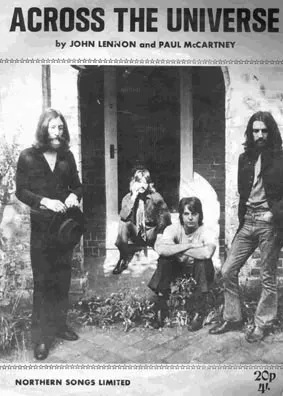 While the vast majority of what eventually became the “Let It Be” album was recorded in January of 1969, circumstances resulted in resurrecting a Beatles recording session that occurred nearly a year earlier. Since a filmed segment of the group rehearsing John's song “Across The Universe” at Twickenham Studios was earmarked to be included in the “Let It Be” movie, a song that was eventually dropped from consideration for the project at that time, a decision was made to include a version of this beautiful Lennon composition on the soundtrack album. While the vast majority of what eventually became the “Let It Be” album was recorded in January of 1969, circumstances resulted in resurrecting a Beatles recording session that occurred nearly a year earlier. Since a filmed segment of the group rehearsing John's song “Across The Universe” at Twickenham Studios was earmarked to be included in the “Let It Be” movie, a song that was eventually dropped from consideration for the project at that time, a decision was made to include a version of this beautiful Lennon composition on the soundtrack album.
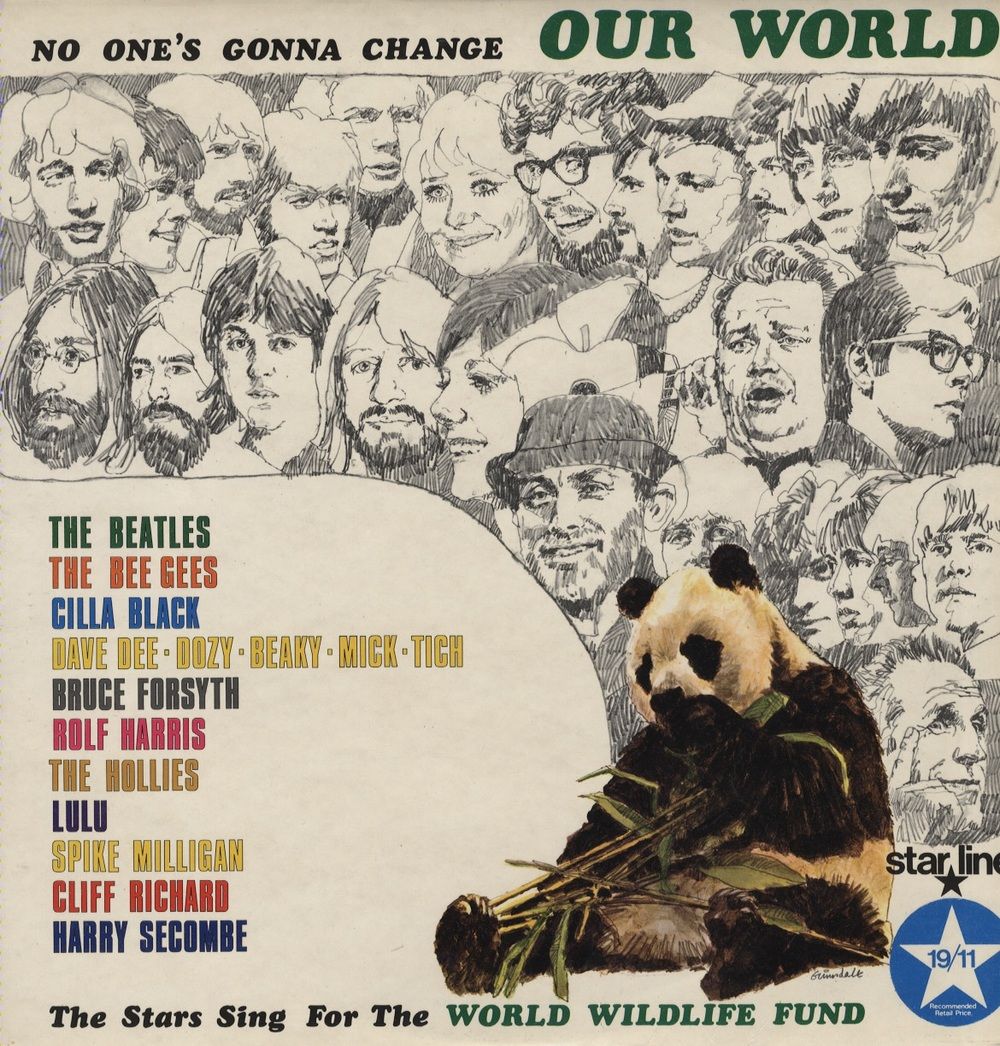 On February 4th, 1968, during the week of sessions that brought about their “Lady Madonna / The Inner Light” single, John introduced “Across The Universe” to his bandmates. They spent a considerable amount of time recording a stunning version of the song on this day and February 8th which did not end up satisfying its composer. It thereby did not get released in 1968, being relegated to a rather obscure charity album entitled “No One's Gonna Change Our World,” which eventually saw a December 1969 release. On February 4th, 1968, during the week of sessions that brought about their “Lady Madonna / The Inner Light” single, John introduced “Across The Universe” to his bandmates. They spent a considerable amount of time recording a stunning version of the song on this day and February 8th which did not end up satisfying its composer. It thereby did not get released in 1968, being relegated to a rather obscure charity album entitled “No One's Gonna Change Our World,” which eventually saw a December 1969 release.
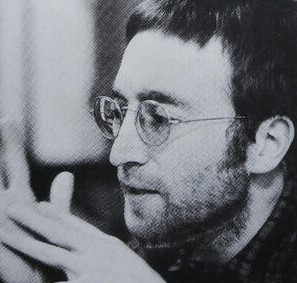 John saw no conflict in allowing Phil Spector to dig out the original February 1968 session tapes in order to alter them in any way he saw fit for inclusion on the 1970 soundtrack album. And this he did, which therefore brings the beginning date for recording the “Let It Be” album to February 4th, 1968. John saw no conflict in allowing Phil Spector to dig out the original February 1968 session tapes in order to alter them in any way he saw fit for inclusion on the 1970 soundtrack album. And this he did, which therefore brings the beginning date for recording the “Let It Be” album to February 4th, 1968.
With the “live performance” intention for the project being satisfied by the rooftop show on January 30th, 1969, overdubbing sessions for these tracks in preperation for their ultimate release were not objected to by anyone. At least at first.
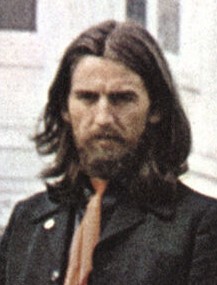 These overdubs included George adding a new lead guitar solo to the song “Let It Be” on April 30th, 1969, this being repeated on January 4th, 1970 along with backing vocals, drums, percussion and brass. George's song “I Me Mine” was officially recorded from scratch on January 3rd, 1970, by George, Paul and Ringo, while George replaced his lead vocals for “For You Blue” on January 8th of that year. These overdubs included George adding a new lead guitar solo to the song “Let It Be” on April 30th, 1969, this being repeated on January 4th, 1970 along with backing vocals, drums, percussion and brass. George's song “I Me Mine” was officially recorded from scratch on January 3rd, 1970, by George, Paul and Ringo, while George replaced his lead vocals for “For You Blue” on January 8th of that year.
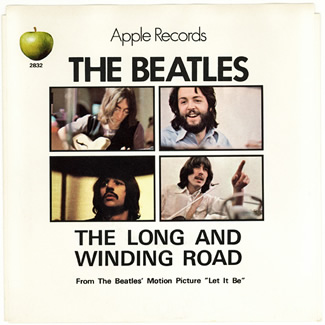 The final recording session for the “Let It Be” album occurred on April 1st, 1970, one that sparked objection from some, including Paul McCartney. Producer Phil Spector arranged for lush orchestral and choral tracks to be added to “Across The Universe,” “I Me Mine” and “The Long And Winding Road,” one of Paul's two vocal tracks of the latter song being erased in the process in order to free up a track for the orchestra. Ringo was brought in for this session to add drums to each song, but Paul wasn't consulted in any way, the composer's intention for “The Long And Winding Road” being a simple piano arrangement without any frilly overdubs. The final recording session for the “Let It Be” album occurred on April 1st, 1970, one that sparked objection from some, including Paul McCartney. Producer Phil Spector arranged for lush orchestral and choral tracks to be added to “Across The Universe,” “I Me Mine” and “The Long And Winding Road,” one of Paul's two vocal tracks of the latter song being erased in the process in order to free up a track for the orchestra. Ringo was brought in for this session to add drums to each song, but Paul wasn't consulted in any way, the composer's intention for “The Long And Winding Road” being a simple piano arrangement without any frilly overdubs.
In any event, the recording sessions for the eventual “Let It Be” soundtrack album spanned from February 4th, 1968 to April 1st, 1970, both of these individual sessions including the recording of “Across The Universe.”
Cover Art
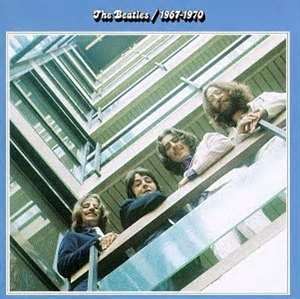 If the album had been released in its earlier incarnations under the title of “Get Back,” the chosen front cover would have been an Angus McBean photo of The Beatles looking over the railing of the inside stairwell at EMI's headquarters at 20 Manchester Square, London, mimicking the cover of their first British album “Please Please Me.” Since this photo had nothing to do with the “Let It Be” film that was to be released in May of 1970, this cover photo was dropped. Since most US fans were unfamiliar with the original “Please Please Me” front cover, the material on this early album having been released in different forms in America in the mid-sixties, the intended impact of this photo would have been lost in the states. It wasn't until 1973 that both the 1963 photo and its 1969 counterpart were revealed to US audiences on their "Red" and "Blue" compilation albums. If the album had been released in its earlier incarnations under the title of “Get Back,” the chosen front cover would have been an Angus McBean photo of The Beatles looking over the railing of the inside stairwell at EMI's headquarters at 20 Manchester Square, London, mimicking the cover of their first British album “Please Please Me.” Since this photo had nothing to do with the “Let It Be” film that was to be released in May of 1970, this cover photo was dropped. Since most US fans were unfamiliar with the original “Please Please Me” front cover, the material on this early album having been released in different forms in America in the mid-sixties, the intended impact of this photo would have been lost in the states. It wasn't until 1973 that both the 1963 photo and its 1969 counterpart were revealed to US audiences on their "Red" and "Blue" compilation albums.
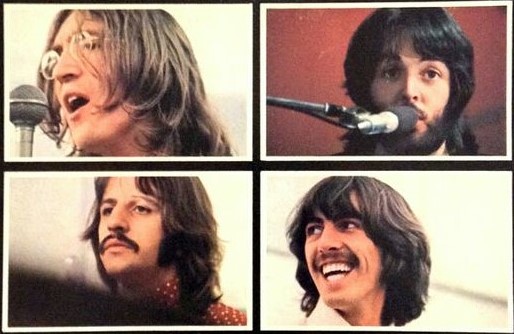 Instead, the front cover of the “Let It Be” album featured four individual pictures of each of The Beatles taken by photographer Ethan Russell during the Twickenham Studios rehearsal sessions in early January of 1969. These photos were cropped appropriately from those that appeared on the picture sleeve of the “Let It Be” single that was released two months prior, which also appeared as the front cover to a 194-page book of pictures and text that accompanied the box set release of the album in the UK and most other countries. Once again, the name “Beatles” was deemed unneccesary for the album's front cover, the only words contained here being “LET IT BE” in block letters above the color photos of the band members. Instead, the front cover of the “Let It Be” album featured four individual pictures of each of The Beatles taken by photographer Ethan Russell during the Twickenham Studios rehearsal sessions in early January of 1969. These photos were cropped appropriately from those that appeared on the picture sleeve of the “Let It Be” single that was released two months prior, which also appeared as the front cover to a 194-page book of pictures and text that accompanied the box set release of the album in the UK and most other countries. Once again, the name “Beatles” was deemed unneccesary for the album's front cover, the only words contained here being “LET IT BE” in block letters above the color photos of the band members.
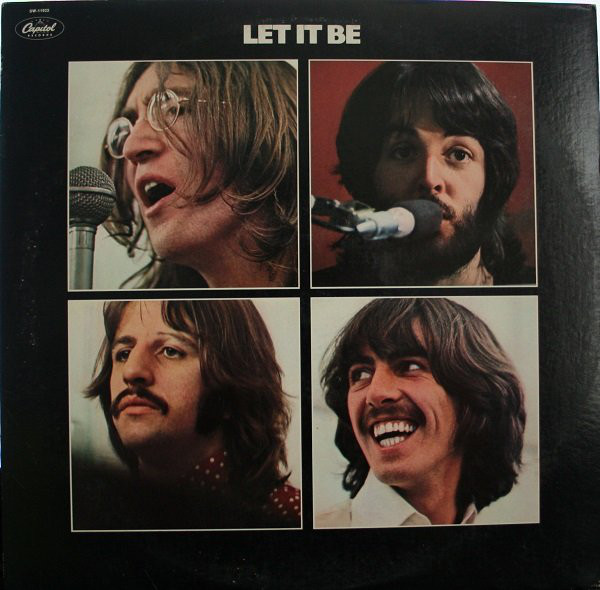 Since the deal was struck with United Artists Records to release this soundtrack album (hence the unusual catalog #AR 34001), it was up to this record label as to whether it would be released in a box-set package as it was in most other countries. They declined this format, presuming that a necessary $10.98 list price to defray the increased production cost would hurt sales. Instead, they opted for a gatefold sleeve that included many Ethan Russell photos on the front, back and inside, this garnering a more reasonable $6.98 list price. The album continued to be issued by United Artists with this gatefold cover until it was dropped by the label a few years after its initial release. When Capitol Records purchased the United Artists record label in 1978, it issued the album in a standard non-gatefold sleeve to further reduce costs, but included a color poster and photo inner sleeve. Since the deal was struck with United Artists Records to release this soundtrack album (hence the unusual catalog #AR 34001), it was up to this record label as to whether it would be released in a box-set package as it was in most other countries. They declined this format, presuming that a necessary $10.98 list price to defray the increased production cost would hurt sales. Instead, they opted for a gatefold sleeve that included many Ethan Russell photos on the front, back and inside, this garnering a more reasonable $6.98 list price. The album continued to be issued by United Artists with this gatefold cover until it was dropped by the label a few years after its initial release. When Capitol Records purchased the United Artists record label in 1978, it issued the album in a standard non-gatefold sleeve to further reduce costs, but included a color poster and photo inner sleeve.
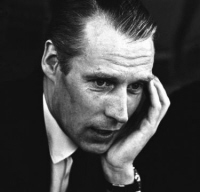 Although George Martin and Glyn Johns were both clearly responsible for the production of the material on the album as it was recorded and initially mixed, the minimal liner notes on the back cover make it quite clear who the producer's credit should be attributed to: “This is a new phase BEATLES album...as reproduced for disc by PHIL SPECTOR.” George Martin had been very vocal about his opinion of Phil Spector's production work on the album, saying it should have been documented as “Produced by George Martin, over-produced by Phil Spector!” “What he did with 'Let It Be,'” George Martin continues, “was to do all the things (and not so well) that we hadn't been allowed to do, and I kind of resented him for it, because to me it was tawdry. It was bringing The Beatles' records down a peg...making them sound like other people's records...When I heard the final sounds I was shaken. They were so uncharacteristic of the clean sounds The Beatles had always used.” Although George Martin and Glyn Johns were both clearly responsible for the production of the material on the album as it was recorded and initially mixed, the minimal liner notes on the back cover make it quite clear who the producer's credit should be attributed to: “This is a new phase BEATLES album...as reproduced for disc by PHIL SPECTOR.” George Martin had been very vocal about his opinion of Phil Spector's production work on the album, saying it should have been documented as “Produced by George Martin, over-produced by Phil Spector!” “What he did with 'Let It Be,'” George Martin continues, “was to do all the things (and not so well) that we hadn't been allowed to do, and I kind of resented him for it, because to me it was tawdry. It was bringing The Beatles' records down a peg...making them sound like other people's records...When I heard the final sounds I was shaken. They were so uncharacteristic of the clean sounds The Beatles had always used.”
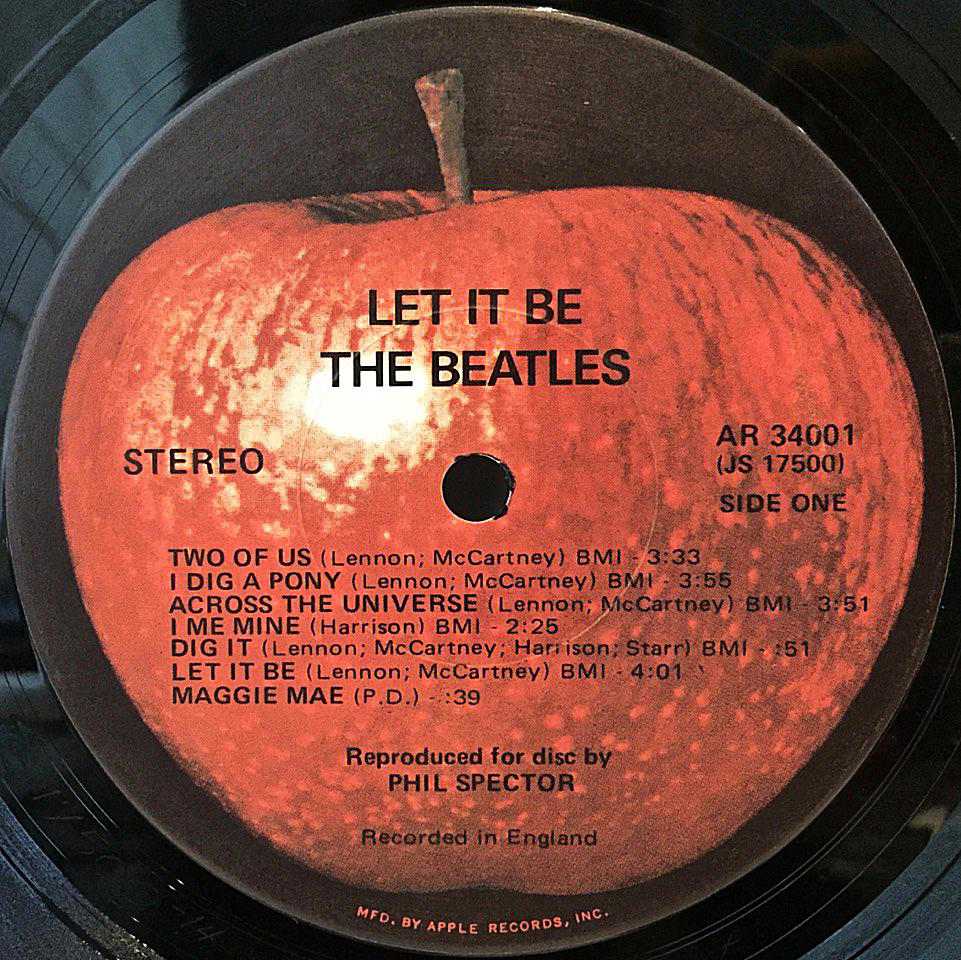 One noticeable difference in the US between this album and previous Beatles albums was the presence of a red apple as the label's logo on both the back cover and the label on the actual disc. Many have speculated as to the reason why there was a change to red instead of the usual green apple, but Allan Steckler, former creative director of Apple Records who was responsible for this change, recalls simply that special albums should have special labels. Therefore, the labels bore a red apple instead of green. This pattern was thereby repeated at times with Apple releases by the individual Beatles, examples including George's “All Things Must Pass” album having orange apples, John's “Plastic Ono Band” album having a white apple, and George's “Extra Texture” label featuring an apple eaten to its core. One noticeable difference in the US between this album and previous Beatles albums was the presence of a red apple as the label's logo on both the back cover and the label on the actual disc. Many have speculated as to the reason why there was a change to red instead of the usual green apple, but Allan Steckler, former creative director of Apple Records who was responsible for this change, recalls simply that special albums should have special labels. Therefore, the labels bore a red apple instead of green. This pattern was thereby repeated at times with Apple releases by the individual Beatles, examples including George's “All Things Must Pass” album having orange apples, John's “Plastic Ono Band” album having a white apple, and George's “Extra Texture” label featuring an apple eaten to its core.

"Let It Be" on eight-track tape.
Success Of The Album
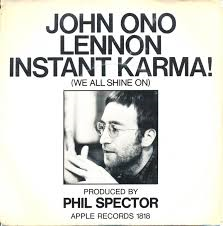 With the recent announcement that The Beatles had broken up, as well as Paul's “McCartney” album at #1 on the Billboard album chart and John's million selling “Instant Karma” single still on the singles chart, the long awaited “Let It Be” album was sure to do well. The “Let It Be” single had recently topped the US singles chart for two weeks with its stunning picture sleeve and now its companion album, with a nearly identical stunning cover, looked irresitible on the shelves of the record stores. With the recent announcement that The Beatles had broken up, as well as Paul's “McCartney” album at #1 on the Billboard album chart and John's million selling “Instant Karma” single still on the singles chart, the long awaited “Let It Be” album was sure to do well. The “Let It Be” single had recently topped the US singles chart for two weeks with its stunning picture sleeve and now its companion album, with a nearly identical stunning cover, looked irresitible on the shelves of the record stores.
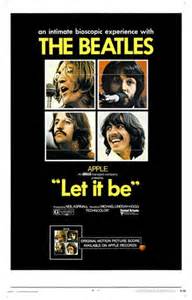 With the “Let It Be” film debuting in movie theaters just three days before the album hit the shops, the soundtrack album and film were the perfect vehicles to celebrate the band that captured the hearts of America throughout the sixties. Not only could they enjoy listening to what many anticipated as the best Beatles album of their career, hot on the heals of the highly respected “Abbey Road” album, but audiences could also actually witness the album being created when watching the movie. What could be better? With the “Let It Be” film debuting in movie theaters just three days before the album hit the shops, the soundtrack album and film were the perfect vehicles to celebrate the band that captured the hearts of America throughout the sixties. Not only could they enjoy listening to what many anticipated as the best Beatles album of their career, hot on the heals of the highly respected “Abbey Road” album, but audiences could also actually witness the album being created when watching the movie. What could be better?
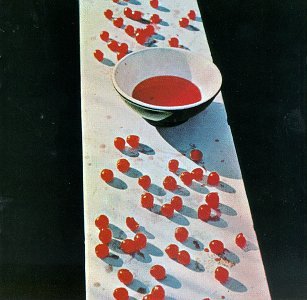 Because of the lateness in the week that the “Let It Be” album was released, it debuted on the Billboard album chart on May 30th, 1970 only at #104. However, the following week it zoomed up to #2, ironically not being able to bypass Paul's “McCartney” album at the top spot for its third week. Although the three other Beatles tried hard to convince Paul to hold off on releasing his album until after the “Let It Be” soundtrack album and film was released, Paul stubbornly held his ground and had “McCartney” released a full month earlier, beating The Beatles' final album to the top of the charts. With the final round of Beatlemania in full swing at this time, neither release suffered as to sales or chart action as was feared. Because of the lateness in the week that the “Let It Be” album was released, it debuted on the Billboard album chart on May 30th, 1970 only at #104. However, the following week it zoomed up to #2, ironically not being able to bypass Paul's “McCartney” album at the top spot for its third week. Although the three other Beatles tried hard to convince Paul to hold off on releasing his album until after the “Let It Be” soundtrack album and film was released, Paul stubbornly held his ground and had “McCartney” released a full month earlier, beating The Beatles' final album to the top of the charts. With the final round of Beatlemania in full swing at this time, neither release suffered as to sales or chart action as was feared.
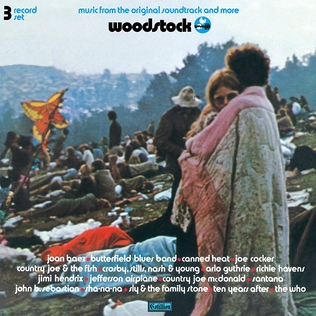 After one week at #2 on Billboard, “Let It Be” then toppled “McCartney” from the top spot on June 13th, 1970, beginning its four week run at #1. The soundtrack to “Woodstock” finally surpassed The Beatles soundtrack album in the top spot on July 11th of that year. Manager Allen Klein reported that the album shipped 3.2 million copies in 13 days, the LP being certified gold on May 26th, 1970, eight days after its release. It eventually was certified 4x Platinum in the US, selling well over four million copies. After one week at #2 on Billboard, “Let It Be” then toppled “McCartney” from the top spot on June 13th, 1970, beginning its four week run at #1. The soundtrack to “Woodstock” finally surpassed The Beatles soundtrack album in the top spot on July 11th of that year. Manager Allen Klein reported that the album shipped 3.2 million copies in 13 days, the LP being certified gold on May 26th, 1970, eight days after its release. It eventually was certified 4x Platinum in the US, selling well over four million copies.
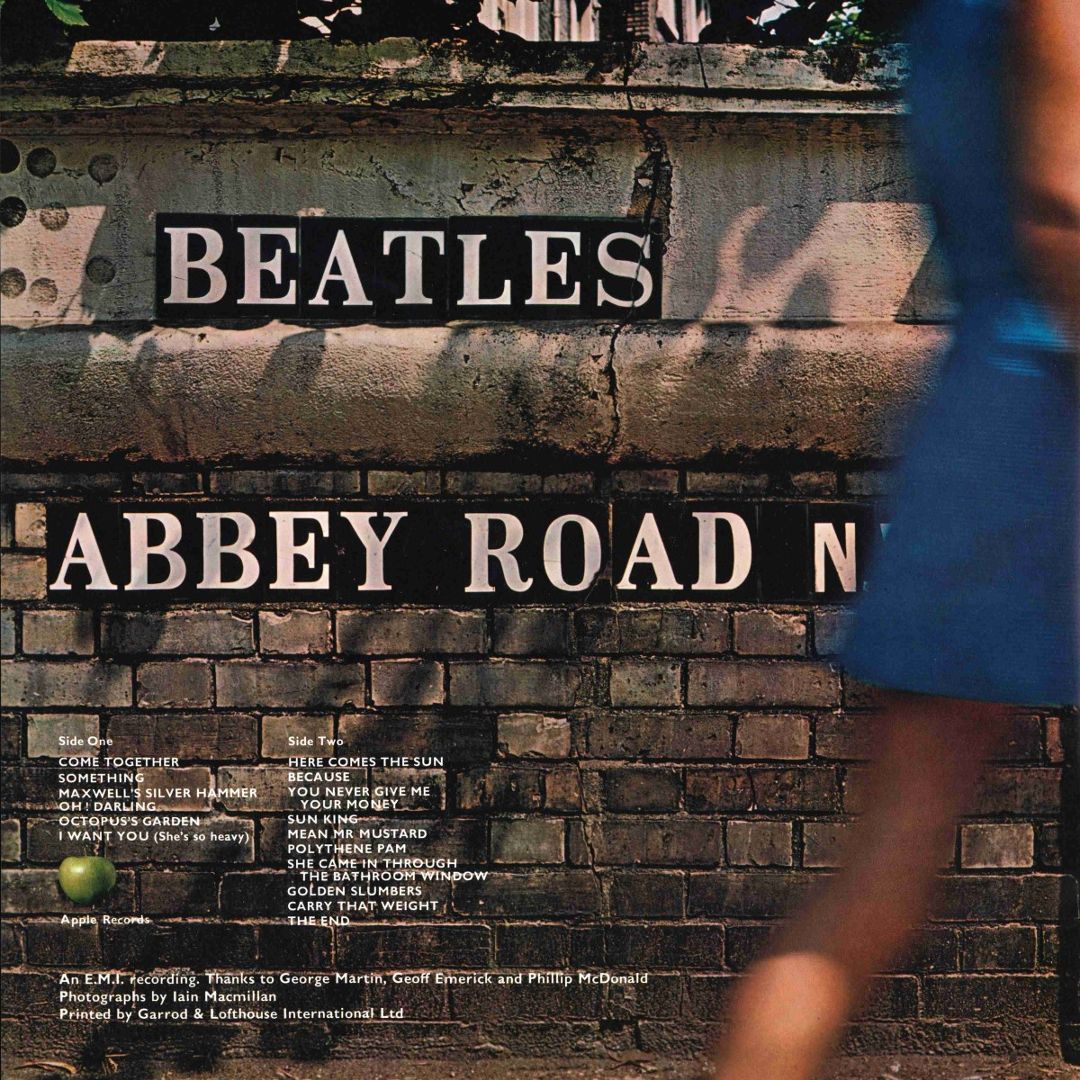 With the highly acclaimed “Abbey Road” album fresh on people's minds, it was inevitable that the music contained on “Let It Be” wouldn't meet up with the expectations and hype surrounding its release. The film depicted various moments of what appeared to be the break-up of the band, an event that was announced right before the film and album were released. In fact, as fans watched the movie, and thereby listened to the soundtrack album, many were looking for such signs of collapse, the film-makers and editors making sure viewers witnessed that which appeared to be the case. With the highly acclaimed “Abbey Road” album fresh on people's minds, it was inevitable that the music contained on “Let It Be” wouldn't meet up with the expectations and hype surrounding its release. The film depicted various moments of what appeared to be the break-up of the band, an event that was announced right before the film and album were released. In fact, as fans watched the movie, and thereby listened to the soundtrack album, many were looking for such signs of collapse, the film-makers and editors making sure viewers witnessed that which appeared to be the case.
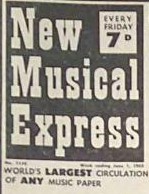 This, undoubtedly, hurt sales of the album slightly, this release not being able to continue the momentum set by “Abbey Road,” which stayed at #1 for eleven weeks and was reported to have been the biggest selling album in Beatles history. Critical response to the soundtrack album was mostly unfavorable, “New Musical Express” critic Alan Smith famously describing the LP as “a cheapskate epitath, a cardboard tombstone,” despite the three US #1 hit singles it eventually contained. This, undoubtedly, hurt sales of the album slightly, this release not being able to continue the momentum set by “Abbey Road,” which stayed at #1 for eleven weeks and was reported to have been the biggest selling album in Beatles history. Critical response to the soundtrack album was mostly unfavorable, “New Musical Express” critic Alan Smith famously describing the LP as “a cheapskate epitath, a cardboard tombstone,” despite the three US #1 hit singles it eventually contained.
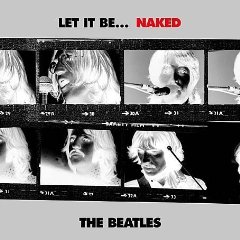 Its reputation appears to have worsened as time went on, culminating in the 2003 release of an album entitled “Let It Be...Naked,” which stripped away all of the Phil Spector production. Many fans favor this version of the album, which provides a vibrant remix of all of the songs of that period, and returns John's “Don't Let Me Down” to its rightful place among the material recorded at the time. Its reputation appears to have worsened as time went on, culminating in the 2003 release of an album entitled “Let It Be...Naked,” which stripped away all of the Phil Spector production. Many fans favor this version of the album, which provides a vibrant remix of all of the songs of that period, and returns John's “Don't Let Me Down” to its rightful place among the material recorded at the time.
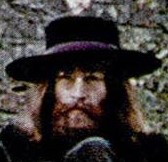 Nonetheless, as a piece of history, the original “Let It Be” album as released in 1970, orchestration and all, does indeed reflect what The Beatles (minus Paul) wanted the public to hear. As John himself explained: “When Spector came, it was 'go and do your audition.' And he worked like a pig on it. He'd always wanted to work with The Beatles and he was given the sh*ttiest load of badly recorded sh*t with a lousy feeling to it ever, and he made something out of it. He did a great job. When I heard it, I didn't puke.” Nonetheless, as a piece of history, the original “Let It Be” album as released in 1970, orchestration and all, does indeed reflect what The Beatles (minus Paul) wanted the public to hear. As John himself explained: “When Spector came, it was 'go and do your audition.' And he worked like a pig on it. He'd always wanted to work with The Beatles and he was given the sh*ttiest load of badly recorded sh*t with a lousy feeling to it ever, and he made something out of it. He did a great job. When I heard it, I didn't puke.”
Written and compiled by Dave Rybaczewski
CLICK ON THE SONG TITLES BELOW TO READ THE IN-DEPTH HISTORY OF THE SONGS ON "LET IT BE"
|
IF YOU WOULD LIKE TO MAKE A DONATION TO KEEP THIS WEBSITE UP AND RUNNING, PLEASE CLICK BELOW!
Sign Up Below for our MONTHLY BEATLES TRIVIA QUIZ!
|